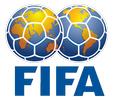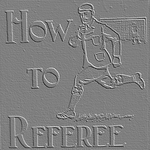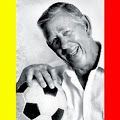 This Video from the... Ken Aston Referee Society -
This Video from the... Ken Aston Referee Society -
 Channel Channel

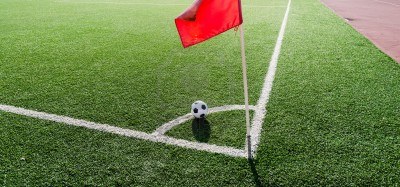
A corner kick is a method of restarting play.
 -
A goal may be scored directly from a corner kick, but only against the
opposing team.
-
A goal may be scored directly from a corner kick, but only against the
opposing team.
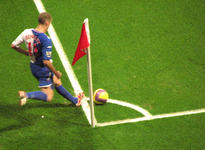 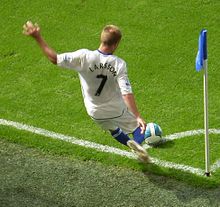 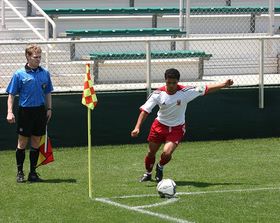 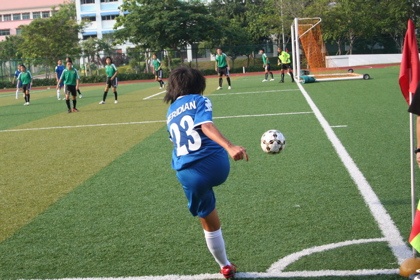
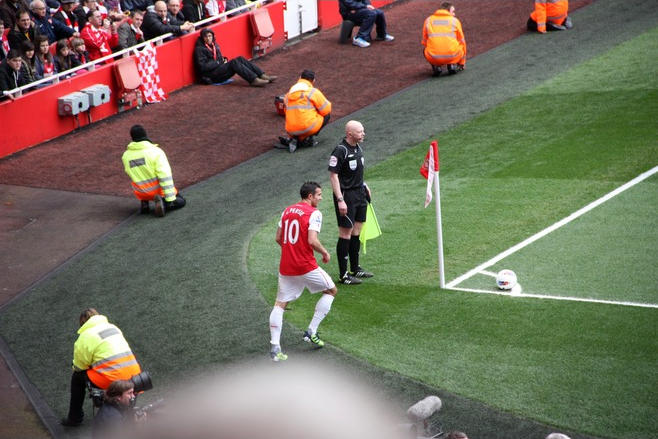
A corner kick is awarded when:
The whole of the ball, having last touched a player of the defending
team, passes over the goal line, either on the ground or in the air, and
a goal is not scored in accordance with Law 10
Procedure
 - The ball is placed inside the corner arc at the nearest corner flag
post
- The ball is placed inside the corner arc at the nearest corner flag
post
 - The corner flag post is not moved
- The corner flag post is not moved
 - Opponents remain at least 9.15 m (10 yds) from the ball until it is in
play
- Opponents remain at least 9.15 m (10 yds) from the ball until it is in
play
 - The ball is kicked by a player of the attacking team
- The ball is kicked by a player of the attacking team
 - The ball is in play when it is kicked and moves
- The ball is in play when it is kicked and moves
 - The kicker does not play the ball a second time until it has touched
another player
- The kicker does not play the ball a second time until it has touched
another player
Infringements/Sanctions
Corner kick taken by a player
other than the goalkeeper If, after the ball is in play,
the kicker
touches the ball a second time (except with his hands),
before it has
touched another player:
 - An indirect free kick is awarded to the opposing team, the kick to be
taken from the place where the infringement occurred
- An indirect free kick is awarded to the opposing team, the kick to be
taken from the place where the infringement occurred
If, after the ball is in play,
the
kicker deliberately handles the ball before it has touched another
player:
 - A direct free kick is awarded to the opposing team, the kick to be
taken from the place where the infringement occurred
- A direct free kick is awarded to the opposing team, the kick to be
taken from the place where the infringement occurred
 - A penalty kick is awarded if the infringement occurred inside the
kicker's penalty area
- A penalty kick is awarded if the infringement occurred inside the
kicker's penalty area
Corner kick taken by the
goalkeeper
If, after the ball is in play,
the
goalkeeper touches the ball a second time (except with his hands)
before
it has touched another player:
 - An indirect free kick is awarded to the opposing team, the kick to be
taken from the place where the infringement occurred
- An indirect free kick is awarded to the opposing team, the kick to be
taken from the place where the infringement occurred
If, after the ball is in play,
the
goalkeeper deliberately handles the ball before it has touched another
player:
 - A direct free kick is awarded to the opposing team if the infringement
occurred outside the goalkeeper's penalty area, the kick to be taken
from the place where the infringement occurred
- A direct free kick is awarded to the opposing team if the infringement
occurred outside the goalkeeper's penalty area, the kick to be taken
from the place where the infringement occurred
 - An indirect free kick is awarded to the opposing team if the
infringement occurred inside the goalkeeper's penalty area, the kick to
be taken from the place where the infringement occurred
- An indirect free kick is awarded to the opposing team if the
infringement occurred inside the goalkeeper's penalty area, the kick to
be taken from the place where the infringement occurred
For any other infringement:
 - The kick is retaken
- The kick is retaken
Law 17 - The Corner Kick
To recognize a correct corner kick
And
How to deal with any infringements.
1.
Introduction:
2. Procedure:
3. Infringements/Sanctions:
4. Action by Referee and Assistant Referees: Including
positioning.
5.Questions & Answers: |
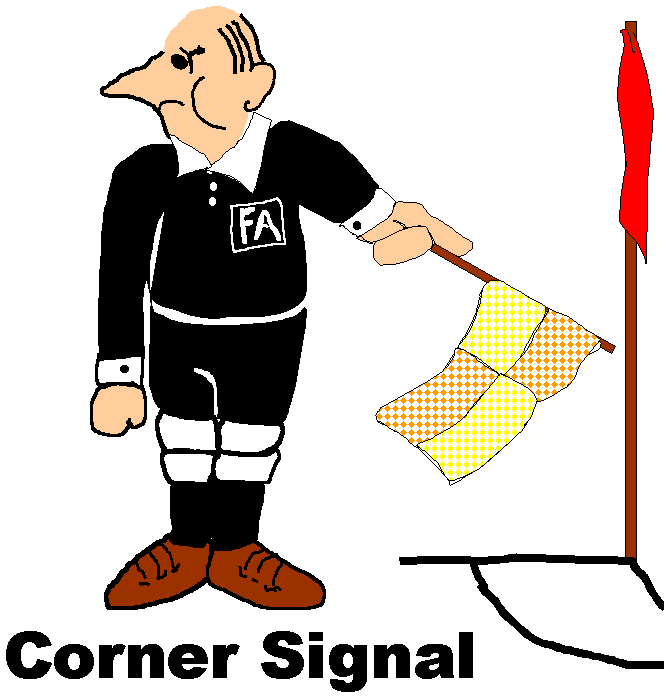 |
1. Introduction:
A corner kick is a method of restarting play.
A goal may be scored directly from a corner kick, but only against the
opposing team.
You cannot be offside direct from a corner kick.
A corner kick is awarded when:
 - The whole of the ball, having last touched a player of the defending
team, passes over the goal line, either on the ground or in the air, and
a goal is not scored in accordance with Law 10.
- The whole of the ball, having last touched a player of the defending
team, passes over the goal line, either on the ground or in the air, and
a goal is not scored in accordance with Law 10.
2. Procedure:
 - The ball is placed inside the corner arc at the nearest corner flag
post from where the ball left the field of play. The ball must be inside
the quarter circle, or be on the quarter circle line - this includes
when the ball is partly outside but hanging over one of the lines. As
long as part of the ball touches or overhangs the line of the quarter
circle, the corner kick is legal. The quarter circle line itself is part
of the arc area; therefore the ball is only outside of that area, when
the whole of the ball is outside of the vertical plane of the line
itself (the same applies to the touchline boundary line when a throw-in
is awarded.) The ball only leaves any area of the field of play, when it
has passed wholly over one of the boundary lines that encompass that
particular area.
- The ball is placed inside the corner arc at the nearest corner flag
post from where the ball left the field of play. The ball must be inside
the quarter circle, or be on the quarter circle line - this includes
when the ball is partly outside but hanging over one of the lines. As
long as part of the ball touches or overhangs the line of the quarter
circle, the corner kick is legal. The quarter circle line itself is part
of the arc area; therefore the ball is only outside of that area, when
the whole of the ball is outside of the vertical plane of the line
itself (the same applies to the touchline boundary line when a throw-in
is awarded.) The ball only leaves any area of the field of play, when it
has passed wholly over one of the boundary lines that encompass that
particular area.
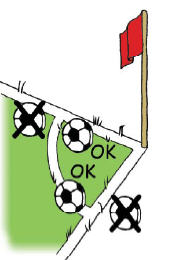
 - The corner flag post is not moved or removed, and must remain upright. - The corner flag post is not moved or removed, and must remain upright.
 - Opponents remain at least 9.15 m (10 yds) from the ball until it is in play. If players continue to encroach after they have been warned -
caution them. - Opponents remain at least 9.15 m (10 yds) from the ball until it is in play. If players continue to encroach after they have been warned -
caution them.
 - The ball is kicked by a player of the attacking team. - The ball is kicked by a player of the attacking team.
 - The ball is in play as soon as it kicked and moves. Only minimal
movement is needed to bring the ball into play. - The ball is in play as soon as it kicked and moves. Only minimal
movement is needed to bring the ball into play.
 - Once the ball is in play, the kicker does not play the ball a second
time until it has touched another player - Once the ball is in play, the kicker does not play the ball a second
time until it has touched another player
 - The ball must be stationary prior to taking the corner kick - The ball must be stationary prior to taking the corner kick
 - The player taking the corner kick can stand off the field, beyond the touch line or beyond the goal line. - The player taking the corner kick can stand off the field, beyond the touch line or beyond the goal line.
3. Infringements/Sanctions:
Corner kick taken by a player other than the goalkeeper
If, after the ball is in play, the kicker touches the ball a second time
(except with his hands), before it has touched another player:
 - An indirect free kick is awarded to the opposing team, the kick to be
taken from the place where the infringement occurred
- An indirect free kick is awarded to the opposing team, the kick to be
taken from the place where the infringement occurred
If, after the ball is in play, the kicker deliberately handles the ball
before it has touched another player:
 - A direct free kick is awarded to the opposing team, the kick to be
taken from the place where the infringement occurred
- A direct free kick is awarded to the opposing team, the kick to be
taken from the place where the infringement occurred
 - A penalty kick is awarded if the infringement occurred inside the
kicker's penalty area
- A penalty kick is awarded if the infringement occurred inside the
kicker's penalty area
Corner kick taken by the
goalkeeper
 - If, after the ball is in play, the goalkeeper touches the ball a
second time (except with his hands) before it has touched another
player:
- If, after the ball is in play, the goalkeeper touches the ball a
second time (except with his hands) before it has touched another
player:
 - An indirect free kick is awarded to the opposing team, the kick to be
taken from the place where the infringement occurred
- An indirect free kick is awarded to the opposing team, the kick to be
taken from the place where the infringement occurred
If, after the ball is in play, the goalkeeper deliberately handles the
ball before it has touched another player:
 - A direct free kick is awarded to the opposing team if the infringement
occurred outside the goalkeeper's penalty area, the kick to be taken
from the place where the infringement occurred
- A direct free kick is awarded to the opposing team if the infringement
occurred outside the goalkeeper's penalty area, the kick to be taken
from the place where the infringement occurred
 - An indirect free kick is awarded to the opposing team if the
infringement occurred inside the goalkeeper's penalty area, the kick to
be taken from the place where the infringement occurred
- An indirect free kick is awarded to the opposing team if the
infringement occurred inside the goalkeeper's penalty area, the kick to
be taken from the place where the infringement occurred
For any other infringement:
 - The kick is retaken
- The kick is retaken
For example, if during the taking of a corner kick, the opponents
encroach within ten yards of the quarter circle, the kick should be
retaken - unless of course the team taking the corner kick have gained
an advantage such as scoring direct from the corner kick - in this case,
you should allow the goal.
 - If during the taking of a corner kick, the ball is kicked immediately
over the goal line, the correct restart is a goal kick to the opposing
team.
- If during the taking of a corner kick, the ball is kicked immediately
over the goal line, the correct restart is a goal kick to the opposing
team.
 - If during the taking of a corner kick, the ball is kicked immediately
over the touchline, the correct restart is a throw-in to the opposing
team.
- If during the taking of a corner kick, the ball is kicked immediately
over the touchline, the correct restart is a throw-in to the opposing
team.
4. Action by Referee and Assistant
Referees:
The Referee should take the following actions during and after a corner
kick has been awarded:
The Referee should
signal the award of a corner kick by pointing an outstretched,
45 degree upwards arm towards the corner of the field of play
where the corner kick is to be taken - and hold this signal for
a minimum of 5 seconds.
This will demonstrate to the players
that you have awarded a corner kick, and from which side the
corner kick should be taken from.
It is important to place the
arm at this acute upwards angle, towards the corner, else
players may become confused and undecided as to whether a goal
kick, a penalty kick or a corner has been awarded. |
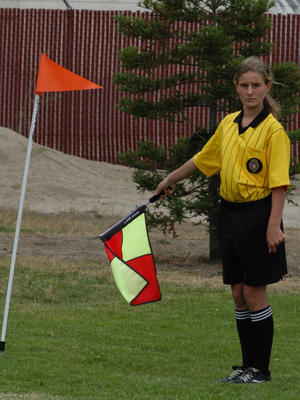 |
 - You do not necessarily have to blow your whistle when awarding every
corner kick. You only need to blow the whistle if players are in any
doubt as to whether you have decided that the ball has actually traveled
out of play over the goal line for either a corner kick or a goal kick,
and play must be stopped.
- You do not necessarily have to blow your whistle when awarding every
corner kick. You only need to blow the whistle if players are in any
doubt as to whether you have decided that the ball has actually traveled
out of play over the goal line for either a corner kick or a goal kick,
and play must be stopped.
 - Once you have indicated a corner kick, move to the position you wish
to be, during the taking of the corner. Keep a close eye on the players
inside the penalty area before the corner kick has been taken. Players
have a habit of trying to psyche up the opposition before a corner kick
is taken - by jostling, pulling shirts, leaning, jumping up in front of
the goal keeper, and generally running around in circles about like mad
men etc..... You need about three pairs of eyes to see everything. Be
aware also, of fouls committed whilst the ball is in flight following
the taking of a corner kick.
- Once you have indicated a corner kick, move to the position you wish
to be, during the taking of the corner. Keep a close eye on the players
inside the penalty area before the corner kick has been taken. Players
have a habit of trying to psyche up the opposition before a corner kick
is taken - by jostling, pulling shirts, leaning, jumping up in front of
the goal keeper, and generally running around in circles about like mad
men etc..... You need about three pairs of eyes to see everything. Be
aware also, of fouls committed whilst the ball is in flight following
the taking of a corner kick.
 - The corner kick should be taken on the side of the field where the
ball passed over the goal line. If you are in any doubt as to which side
of the field the corner kick should be taken from, just make a positive
decision one way or the other - does it really matter??
- The corner kick should be taken on the side of the field where the
ball passed over the goal line. If you are in any doubt as to which side
of the field the corner kick should be taken from, just make a positive
decision one way or the other - does it really matter??
Referee's Position during the
taking of a corner kick:
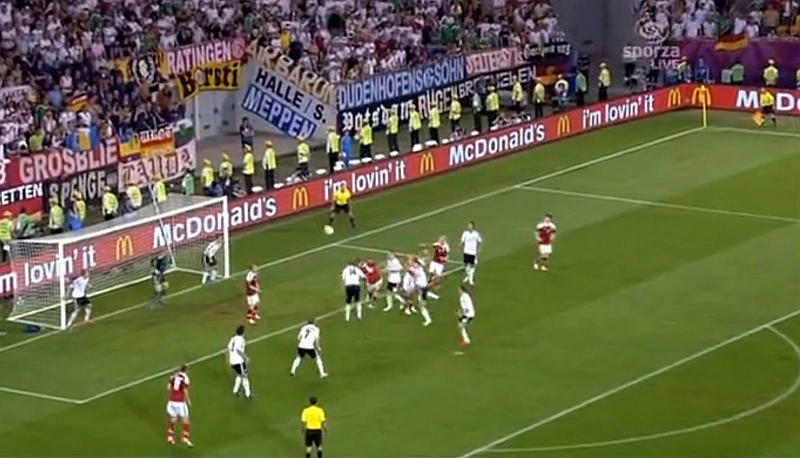
Keep the following points
in mind:
 - Try and position yourself so that the players are between you and the
Assistant Referee.
- Try and position yourself so that the players are between you and the
Assistant Referee.
 - Never take your eyes off the players immediately before a corner kick
is taken. This is another common mistake made by new Referees. It only
takes a second for a player to intimidate an opponent by pushing and
shoving before the corner kick has even taken place - and all done when
you (the Referee) are walking to your position with your back to the
players!!
- Never take your eyes off the players immediately before a corner kick
is taken. This is another common mistake made by new Referees. It only
takes a second for a player to intimidate an opponent by pushing and
shoving before the corner kick has even taken place - and all done when
you (the Referee) are walking to your position with your back to the
players!!
 - If players are misbehaving themselves before the corner kick has been
taken, stop play immediately by blowing your whistle loudly, and
strongly warn players about their unsporting conduct.
- If players are misbehaving themselves before the corner kick has been
taken, stop play immediately by blowing your whistle loudly, and
strongly warn players about their unsporting conduct.
 - Do not stand anywhere in the goal area - unless you want your head
knocked off!!
- Do not stand anywhere in the goal area - unless you want your head
knocked off!!
 - Always blow your whistle to signal that the corner kick can now be
taken. (This is probably the only situation where I always blow my
whistle. It gives players a clear signal that the corner kick is about
to be taken, and prevents any misunderstanding should a goal be scored.)
- Always blow your whistle to signal that the corner kick can now be
taken. (This is probably the only situation where I always blow my
whistle. It gives players a clear signal that the corner kick is about
to be taken, and prevents any misunderstanding should a goal be scored.)
 - If Assistant Referees are available, vary your position at each corner
kick. If you take up the same position during the entire corner kicks in
a game, players will soon exploit this by fouling opponents on your
blind side. Keep the players guessing by moving around during corner
kicks.
- If Assistant Referees are available, vary your position at each corner
kick. If you take up the same position during the entire corner kicks in
a game, players will soon exploit this by fouling opponents on your
blind side. Keep the players guessing by moving around during corner
kicks.
 - If you only have Club Assistant Linesmen (or no linesmen at all),
always stand on the goal line. It is vitally important that you alone
will be the goal judge in this situation. Some Referees will disagree
with this positioning - but I believe that being in a position to see
whether or not the ball has crossed the goal line for a goal - or not,
is slightly more important than any other aspect during the taking of a
corner kick.
- If you only have Club Assistant Linesmen (or no linesmen at all),
always stand on the goal line. It is vitally important that you alone
will be the goal judge in this situation. Some Referees will disagree
with this positioning - but I believe that being in a position to see
whether or not the ball has crossed the goal line for a goal - or not,
is slightly more important than any other aspect during the taking of a
corner kick.
 - Check that the corner kick taker has placed the ball correctly inside
the quarter circle if the corner is being taken on the opposite side of
the field of play to your Assistant Referee.
- Check that the corner kick taker has placed the ball correctly inside
the quarter circle if the corner is being taken on the opposite side of
the field of play to your Assistant Referee.
 - If the corner is being taken on the opposite side of the field of play
to your Assistant Referee, ensure that opposing players do not encroach
within ten yards of the ball before the corner kick has been taken.
- If the corner is being taken on the opposite side of the field of play
to your Assistant Referee, ensure that opposing players do not encroach
within ten yards of the ball before the corner kick has been taken.
The Assistant Referee
should take the following actions to signal to the Referee
that the ball
has passed over the goal line
for a corner kick, and to check that the
corner kick taker completes the kick correctly.
 - To signal a corner kick, stand facing the field of play and point the
flag downwards towards the base of the corner flag.
- To signal a corner kick, stand facing the field of play and point the
flag downwards towards the base of the corner flag.
Or
 - Use body language by running around the corner flag and three or four
yards towards the goal. If there is any dispute between players as to
whether the ball has actually passed over the goal line for a corner
kick - the Assistant Referee should use the previous flagged method.
Using body language, allows the Referee a few moments to overrule the
Assistant Referee, should he wish to do so. By using body language,
players will generally not have a clue as the whether the Assistant
Referee has indicated a goal kick or a corner kick, and this will
prevent any misunderstanding should the Referee indicate a goal kick,
and the Assistant Referee a corner kick!!!!!
- Use body language by running around the corner flag and three or four
yards towards the goal. If there is any dispute between players as to
whether the ball has actually passed over the goal line for a corner
kick - the Assistant Referee should use the previous flagged method.
Using body language, allows the Referee a few moments to overrule the
Assistant Referee, should he wish to do so. By using body language,
players will generally not have a clue as the whether the Assistant
Referee has indicated a goal kick or a corner kick, and this will
prevent any misunderstanding should the Referee indicate a goal kick,
and the Assistant Referee a corner kick!!!!!
 - Check that the corner kick taker has placed the ball correctly inside
the quarter circle if the corner is being taken on your side of the
field of play.
- Check that the corner kick taker has placed the ball correctly inside
the quarter circle if the corner is being taken on your side of the
field of play.
 - Position yourself either behind the corner flag post, or alongside the
goal line depending on the Referee's instructions given to you at the
beginning of the game. The general rule is that Assistant Referees will
position themselves off the field of play behind the kicker, if the kick
is taking place on the Assistant Referees side of the field of play. If
the kick is being taken on the far side of the field of play, the
Assistant Referee will normally position himself on the goal line, about
10 yards down from the corner flag. This allows the Assistant Referee to
act as goal judge, and to enable him to cut across the field of play and
resume his position on the touchline to observe any off sides, if play
should quickly break away up field.
- Position yourself either behind the corner flag post, or alongside the
goal line depending on the Referee's instructions given to you at the
beginning of the game. The general rule is that Assistant Referees will
position themselves off the field of play behind the kicker, if the kick
is taking place on the Assistant Referees side of the field of play. If
the kick is being taken on the far side of the field of play, the
Assistant Referee will normally position himself on the goal line, about
10 yards down from the corner flag. This allows the Assistant Referee to
act as goal judge, and to enable him to cut across the field of play and
resume his position on the touchline to observe any off sides, if play
should quickly break away up field.
 - If the corner is being taken on your side of the field of play, ensure
that opposing players do not encroach within ten yards of the ball
before the corner kick has been taken.
- If the corner is being taken on your side of the field of play, ensure
that opposing players do not encroach within ten yards of the ball
before the corner kick has been taken.
 - Judge whether the ball leaves the field of play whilst in its flight
towards the penalty area.
- Judge whether the ball leaves the field of play whilst in its flight
towards the penalty area.
 - Judge whether the ball has crossed the goal line for a goal.
- Judge whether the ball has crossed the goal line for a goal.
 - Sprint back up the touchline to cover offside as soon as the play
moves up field.
- Sprint back up the touchline to cover offside as soon as the play
moves up field.
 - During the taking of corner
kicks, the Referee should position himself so that the players
in the penalty area are between himself and the Assistant
Referee. The aim is to have the play action within the penalty
area between the Referee and the Assistant Referee.
- During the taking of corner
kicks, the Referee should position himself so that the players
in the penalty area are between himself and the Assistant
Referee. The aim is to have the play action within the penalty
area between the Referee and the Assistant Referee.
 -
Assistant Referees should position themselves either behind the
corner flag post, or alongside the goal line depending on the
Referee's instructions given to them at the beginning of the
game.
-
Assistant Referees should position themselves either behind the
corner flag post, or alongside the goal line depending on the
Referee's instructions given to them at the beginning of the
game.
 -
The main task for the Assistant Referee, is to look for the ball
crossing over the goal line during its flight from the corner
arc, to judge offside when play breaks, and to judge whether the
ball has entered the goal or not. If following a corner kick,
play breaks quickly down-field towards the round team's half,
the Assistant Referee on the right in Fig 3b, can cut across the
corner of the field of play, to reposition himself along the
touchline to watch for off sides etc..
-
The main task for the Assistant Referee, is to look for the ball
crossing over the goal line during its flight from the corner
arc, to judge offside when play breaks, and to judge whether the
ball has entered the goal or not. If following a corner kick,
play breaks quickly down-field towards the round team's half,
the Assistant Referee on the right in Fig 3b, can cut across the
corner of the field of play, to reposition himself along the
touchline to watch for off sides etc..
 -
If Assistant Referees are available, the Referee should vary his
position at each respective corner kick.
-
If Assistant Referees are available, the Referee should vary his
position at each respective corner kick.
 -
If Referees take up the same position during the entire corner
kicks in a game, players will soon exploit this by fouling
opponents on the Referee's 'blind side'.
-
If Referees take up the same position during the entire corner
kicks in a game, players will soon exploit this by fouling
opponents on the Referee's 'blind side'.
 -
Keep the players guessing by moving around during corner kicks.
-
Keep the players guessing by moving around during corner kicks.
 -
Players are very adept at pulling opponents shirts, nudging
them, standing on opponents' feet and all sorts of other
infringements. By varying his position, players do not know
where the Referee will be, and therefore are less likely to
infringe.
-
Players are very adept at pulling opponents shirts, nudging
them, standing on opponents' feet and all sorts of other
infringements. By varying his position, players do not know
where the Referee will be, and therefore are less likely to
infringe.
 -
Whilst a corner kick is taken, the Referee should never take his
eyes off the players in the penalty area. It only takes a second
for a player to intimidate an opponent - and all done when the
Referee is walking to his starting position whilst having his
back to the players!!
-
Whilst a corner kick is taken, the Referee should never take his
eyes off the players in the penalty area. It only takes a second
for a player to intimidate an opponent - and all done when the
Referee is walking to his starting position whilst having his
back to the players!!
 -
The most important aspect for consideration during the taking of
a corner kick is whether a goal is scored or not. The Referee
should also look out for infringements occurring before and
during the taking of the corner kick.
-
The most important aspect for consideration during the taking of
a corner kick is whether a goal is scored or not. The Referee
should also look out for infringements occurring before and
during the taking of the corner kick. |



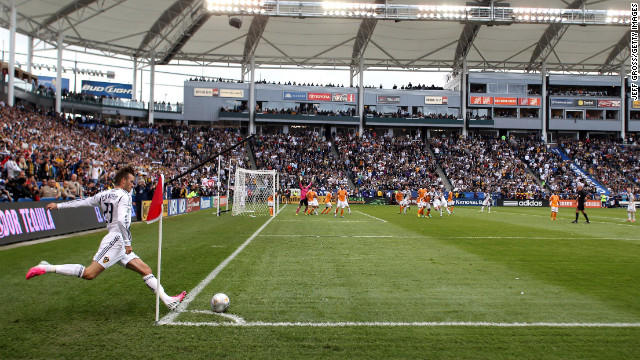 |
 - If players are misbehaving themselves before the corner kick
has been taken, the Referee should stop play immediately by blowing his
whistle loudly, and strongly warn players about their unsporting conduct
(and caution players if necessary).
- If players are misbehaving themselves before the corner kick
has been taken, the Referee should stop play immediately by blowing his
whistle loudly, and strongly warn players about their unsporting conduct
(and caution players if necessary).
 - If the Referee is aware of any possible trouble spots between
players, then he should adjust his positioning to be nearer to the
trouble area, at the same time still keeping a relatively good view of
the remaining action area.
- If the Referee is aware of any possible trouble spots between
players, then he should adjust his positioning to be nearer to the
trouble area, at the same time still keeping a relatively good view of
the remaining action area.
 - Referees should not stand inside the goal area - "unless they
want their head knocked off!!"
- Referees should not stand inside the goal area - "unless they
want their head knocked off!!"
 - Referees are advised to blow their whistle to signal that the
corner kick can be taken. A corner kick entails both teams being
confined in a small area of the field of play jostling for position - a
whistle signal to allow commencement gives players a clear signal that
the corner kick is about to be taken, and prevents any misunderstanding
should a goal be scored (or an infringement occurring) when the Referee
and both teams are not ready.
- Referees are advised to blow their whistle to signal that the
corner kick can be taken. A corner kick entails both teams being
confined in a small area of the field of play jostling for position - a
whistle signal to allow commencement gives players a clear signal that
the corner kick is about to be taken, and prevents any misunderstanding
should a goal be scored (or an infringement occurring) when the Referee
and both teams are not ready.
 - It is not always possible to whistle commencement at all corner
kicks - example, when a quick corner has been taken - in this case, play
should be allowed to continue without a whistle signal.
- It is not always possible to whistle commencement at all corner
kicks - example, when a quick corner has been taken - in this case, play
should be allowed to continue without a whistle signal.
+-+ BACK TO TOP +-+
+-+ FIFA-ADDITIONAL +-+
+-+ ADVICE from 'THE PITCH' +-+
Questions and Answers:
This web site and the advice and answers to any questions are not
sanctioned by or affiliated with any governing body of soccer. The
opinions expressed on this site should not be considered official
interpretations of the Laws of the Game. Although the content of the
latest Laws are included on this site, the majority of the content is
the opinion of the Webmaster and other Referees worldwide. If you need
an official ruling you should contact your local
representative/association or visit the FIFA, or the English FA web
sites for the Laws themselves.
Question 1: A corner kick is
taken by attacker (A). The ball hits the side of the nearest goal post,
and rebounds directly back to the attacker (A) who shoots and directly
scores a goal. What action should the Referee take?
Answer 1: The corner kick taker
attacker (A) is not allowed to touch the ball a second time until
another player has touched it. An indirect free kick should be awarded
to the opposition at the place where the attacker (A) touched the ball
for a second time.
Question 2: During the taking
of a corner kick by a superhuman player, instead of the super-human
player kicking the ball towards his opponent’s goal, he belts it back
towards his own goalkeeper. The lofted ball gets caught in the wind, and
is projected directly into the goal of the superhuman player. What
should the Referee do?
Answer 2: Firstly, pick himself
off the ground!, then award a corner kick at the other end of the field
of play against the superhuman player's team ! (A goal may be scored
directly from a corner kick, but only against the opposing team.)
Question 3: Are players
allowed to crowd out the goalkeeper prior to a corner kick being taken?
Answer 3: Players are entitled
to stand anywhere that they want to on the field of play during the
taking of corner kicks. Nevertheless, if the attacking team purposefully
place several players around the goalkeeper, with the sole purpose of
impeding him during a corner kick - the Referee should award an indirect
free kick to the defending team, ONLY if the goalkeeper is subsequently
impeded from challenging fairly for the ball. In most instances, the
benefit of doubt should be given to the goalkeeper, because of all the
players on the field of play; the goalkeepers are the most vulnerable.
An attacking player standing in front of a goalkeeper will have to
actively move to impede the goalkeeper. There is nothing to stop the
attacker standing still in front of the goalkeeper, but if he makes a
move to block the goalkeeper from gaining possession of the ball - this
is impeding. If the goal area becomes very over-congested, the
likelihood of a foul occurring is increased. At the same time, the
Referee's ability to see exactly what is happening becomes more
difficult. Many Referees tend to err on the side of protecting the
goalkeeper, by awarding free kicks where excessive contact or impedance
is used, even though it may be unclear just exactly what is going on.
If the attackers are standing right in front of the goalkeeper, but move
away to participate in the play when the corner kick is taken, then no
offence has occurred, and the goalkeeper will just have to thread his
way through the attacking players.
Question 4. Prior to a corner
kick being taken, and whilst the ball is being placed in the quarter
circle, and when the players are taking up their positions, several
players are fouling their opponents. What action should the Referee
take?
Answer 4: The ball is still out
of play, so the Referee cannot award a free kick. The Referee can only
discipline the participating players. Normally, such pushing and shoving
is not serious enough for a caution to be administered. If it continues
after the Referee has warned the players to stop, then the Referee must
stop the match and discipline players accordingly.
The Referee can also blast his whistle a few times to remind players to
behave themselves.
If the pushing-shoving-obstruction is being done mostly by the attacking
team, and persists after the corner kick has taken place, most Referees
will immediately award a free kick to the defending team, because the
ball is now in play and a foul can be awarded.
If the pushing and shoving is being done mostly by the defending team,
the Referee will be more inclined to let it go, in the knowledge he can
award a penalty or indirect free kick for obstruction - if it gets out
of hand.
Players will soon let the Referee know if there is a particular opponent
who is consistently fouling them out of the view of the Referee. The
Referee can then ask that player to behave himself. Normally, just a
look towards that culprit will clearly demonstrate that you will be
giving him your closest attention during the taking of the corner kick.
Question 5: From a corner
kick, a ball is played short by the first attacker to a second attacker
who then immediately passes the ball back to the original kicker who has
remained in the quarter circle. The Assistant Referee immediately flags
for offside. Was the Assistant Referee's decision correct?
Answer 5: The second attacker,
who has received the ball from his colleague, cannot be offside direct
from a corner kick. However, at the moment that second attacker touches
the ball, the corner kick is over and normal play resumes. If the first
attacker (who has remained in the quarter circle) is now in an offside
position because the defenders have rushed out from their goal line
positions, then the first attacker is deemed to be offside.

I
once had the pleasure of seeing a corner kick taker, completely miss the ball,
and kick the corner flag instead, which sailed up high into the
air - and he did not mean to either!!!!!!
Question 6: The corner arc is
too small and the flag gets in the way of a player taking the corner
kick. What action should the Referee take?
Answer 6: Irrespective of
whether the arc is the right size or not, the corner flag can not be
removed, and must not be held out of the way when a corner kick is being
taken. If the flag is moved during the taking of the corner kick, then
the corner kick must be retaken. The size of the corner arc should have
been spotted and rectified during the Referee's pre-match pitch
inspection. But is the smallness of the arc really a problem - I do not
think so!!. The arc is supposed to allow the kicker enough room to place
the ball out of the way of the flag post, although it's quite common for
the arc to be too small, and/or to be drawn as a triangle. If it comes
to the crunch and the arc really is far too small, use your common sense
and allow the corner kick to take place so long as the ball is not
blatantly more than 1 yard from the corner of the pitch - does it really
matter?
Question 7: Is an attacking
player allowed to run under the goal net during the taking of a corner
kick?
Answer 7: No. This area is not
part of the field of play or the penalty area.
Beware during corner kicks, of attacking players running into this area
whilst the ball is in play from the corner kick, in an attempt to
distract the goalkeeper. Any such antics should be curtailed. Players
are not allowed to leave the field of play without the Referees
permission. If a goal is scored from a corner, and an attacker has
purposefully run into this area or around the goalkeeper whilst the ball
was in flight, then the goal should not be allowed to stand. This action
is deemed as unfair on the part of the attacking player and can be very
distracting for the goalkeeper.
Law 12 states that "An indirect free kick can be awarded to the opposing
team if a player, in the opinion of the Referee commits any other
offence, not previously mentioned in Law 12, for which play is stopped
to caution or dismiss a player." But because the indirect free kick
needs to be taken where the incident occurred, an indirect free kick
restart cannot be used (because the incident occurred under the goal net
and outside of the field of play and whilst the ball was in play).
Therefore, if the incident occurred outside of the field of play whilst
the ball was in play, the only restart allowed by Law is a dropped ball
to be taken where the ball was when the attacking player stepped under
the goal net. Because the offence actually occurs outside of the field
of play (under the goal net) - the Referee cannot award an indirect free
kick outside of the field of play. The restart for any offences
committed outside of the field of play whilst the ball is still in play
is always dropped ball. The Referee can also caution the attacking
player for either unsporting conduct, or for leaving the field of play
without the Referee's permission.
The correct restart is a dropped ball at the place where the ball was
located when the Referee either stopped play or where the ball was when
the attacking player stepped under the goal net. But it is strongly
advised that the ball be dropped by the Referee straight to the
goalkeeper, and does not involve an attacking player. This way, justice
is seen to have been done, and play can resume fairly.
Question 8: A corner kick is
taken in the last minute of the game and is subsequently cleared up
field by the defending team. As the Referee heads up field by his
diagonal a defender strikes an attacker within the penalty area, but
behind the Referees' back. The assistant Referee who flags to bring the
same to the Referees attention has noted the incident. However as the
Referee enters the other half he blows for full time as he turns around
he spots the neutral Assistants flag and approach him for consultation.
What is the correct course of action?
(a) Stand by the final whistle and report the incident to the county
Football Association, as he cannot show a card after the game has ended.
(b) Award a penalty as the incident occurred within normal play, dismiss
the culprit and then end the game once the kick is taken and the result
of it is known.
Answer 8: from Referees'
Association England: It was unanimously agreed by the committee, and
approved by the Football Association that the culprit must be dismissed
and the penalty taken, once the result of the penalty kick is known the
whistle is blown to terminate the game. The offence happened in normal
time and the laws of the game allow time to be extended for a penalty
kick to be taken.
Question 9: A player sets up
a corner kick; he plays the ball in the arc, and yells to a teammate for
him to take the kick. As this player walks towards him, he gives the
ball a gentle nudge toward the approaching colleague. The teammate acts
like nothing has happened, but then takes the ball under control with
his feet and makes a cross towards goal. Is this legal?
Answer 9: This move is no
different than any other form of verbally trying to distract or tricking
an opponent. The Referee should caution the player, and show the yellow
card for unsporting behavior, and restart with an indirect free kick to
the defending team. (UK RA Magazine Oct. 2001)
The following question discussed and answered by
the UK Referees'
Association I&P Committee differs in its interpretation.
The important
thing to remember is that the above question & answer assumes that a clear act of trickery has taken place,
and such acts have no place in
football and should be strongly punished by the custodians of the
'spirit of the game' - the Referees.
In fact, if you look closely at the
above question,
the first player actually touches the ball a second time
before it has touched
another player this is in addition to the
'trickery' element of the maneuver.
Thus an indirect free kick is
(doubly) the correct restart.
The answer to the question below is an exaggerated example of a typical
(and legal) 'short corner' routine.
There is no distance stipulation
that a colleague of the corner kick taker
has to be from the corner
flag, before a 'short corner' takes place.
The maneuver is therefore
legal, the same as if a throw-in or a free kick is taken quickly,
when a
teammate is some distance away.
Question 10: A corner kick is
to be taken; the kicker rolls the ball outside the quadrant with the top
of his foot. He then runs into the penalty area, and a colleague goes to
collect the ball with the intention of running back into the penalty
area to gain an advantage to his team. Is this allowed or is it against
sporting behavior ethics?
Answer 10: There is nothing
wrong with the circumstances quoted, the ball is in play immediately it
is kicked and moves. Therefore, this example is not against sporting
behavior ethics, or deemed unsporting behavior.
|
